
| Capability (C058):— representing_justification | Date: 2007/06/22 12:22:10 Revision: 1.24 |
This section provides a business level overview of this capability.
This capability represents a record of the reasons for something, such as the reasons for undertaking an activity or the justification for an approval.
This is illustrated in Figure 1 which shows conceptually how the justification is recorded. Figure 2 shows an example in which the activity of mending a tyre is justified by the fact that the tyre had a puncture.


Justification has been used in C046: representing_variance to represent the conditions under which a concession or variance has been granted.
Justification has also been used in C032: representing_activity to represent the fact that properties on a product resulted from the product engaging in a given activity.
This section provides an overview of the information model that supports this capability.
The EXPRESS-G for the activity model is shown in Figure 3 below and explained in the following sections.
The Justification represents the record of the justification.
The subject of the justification is identified by using the relationship Justification_assignment to assign the Justification to the subject.
The reasons for the justification are identified by using the relationship Justification_support_assignment to assign the reasons to the Justification , e.g. a state, a property value, a specific product configuration, a document.
A number of justifications can be related by Justification_relationship.
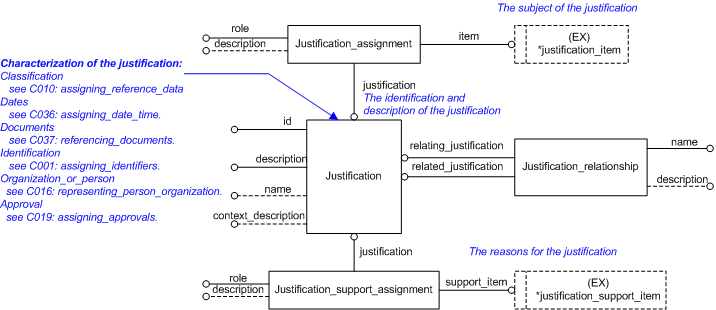
An example of the use of a justification is shown in Figure 4. This shows the justification for a repair activity on bicycle tyre is the fact that the tyre has a puncture. The jsutification is described in text using a descriptor (see C095: assigning_descriptor).
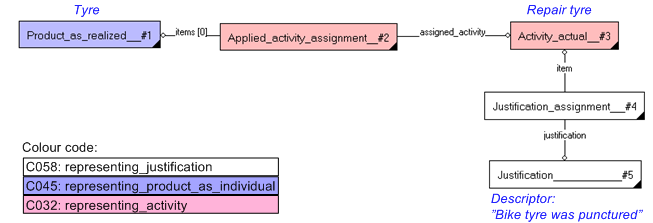
If information that supports the justifiction exists, e.g. a State_observed, it should be related to the justification using Justification_support_assignment. An example is shown in Figure 5.
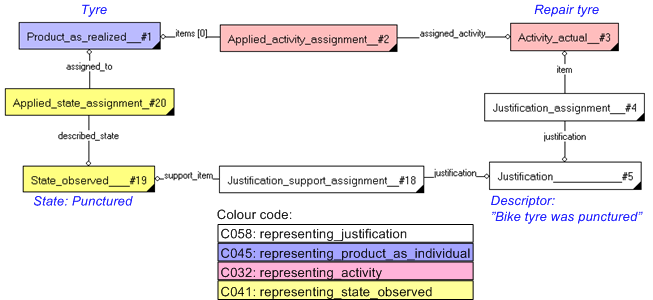
A statement that summarizes the justification must always be assigned to it, even if one or more support items have been related to it. Sometimes this statement is unsupported, in which case the Justification_support_assignment should not be used.
The statement is attached to the Justification by use of template assigning_descriptor.
NOTE The assignment of descriptor to a Justification is an issue with AP239. See "AP239 issues" under the "Tools" section, issue RBN-5 2007-02-01.
Issue: TJT-2 by Tim Turner (06-04-15) [minor_technical, open] - {Type = contents}
This capability needs reference data for the justification, the justification_assignment, and the justification_support_assignment, and justification_relationships..
Issue: NN-1 by Nigel Newling (05-11-17) [minor_technical, open] - {Type = contents}
Reference data section with example classes required.
Issue: TJT-1 by Tim Turner (06-04-15) [editorial, closed] - {Type = contents}
This capability needs a template to allow the assignment of a justification to an item and a related instance of justification_support_assignment to be assigned a support item.Comment: (Peter Bergström 2007-02-02)
Two templates have been created: assigning_justification, and assigning_justification_support_item.
Issue: TJT-3 by Tim Turner (06-04-15) [minor_technical, closed] - {Type = contents}
This capability needs to reference the use of a document to capture justification statements, and associated reference data.Comment: (Peter Bergström 2007-02-02)
Simple textual descriptions of the justification has been added through template assigning_descriptor. Further supportive information could be assigned to a justification through justification_support_item, which may relate a document in a specific role to the justification.
See also AP239 issues, issue RBN-5 2007-02-01.
Issue: TJT-4 by Tim Turner (06-04-15) [minor_technical, closed] - {Type = contents}
It is not clear where the actual justification text/reasons are to be recorded - either in the justification.description attribute, or through the use of assigning_descriptors..Comment: (Peter Bergström 2007-02-02)
Simple textual descriptions of the justification has been added through template assigning_descriptor. Further supportive information could be assigned to a justification through justification_support_item, which may relate a document in a specific role to the justification.
See also AP239 issues, issue RBN-5 2007-02-01.
The Justification_assignment and Justification_support_assignment must be classified using Classification_assignment to assign an External_class, where the External_class is defined as reference data stored in a reference data library.
The Justification_assignment is classified to give the reason for the jsutification, such as cost or safety. It should be classified using "Justification assignment" (urn:plcs:rdl:std:Justification assignment) or one of its subclasses.
The Justification_support_assignment is classified to give the role of the supporting item to the justification, e.g. property value, observed state or condition that supports the justification. It should be classified using "Justification support assignment" (urn:plcs:rdl:std:Justification support assignment) or one of its subclasses.
The Justification may be identified by assigning it an identifier through the use of Identification_assignment.
NOTE Identification is described in C001: assigning_identifiers.
The Justification can be "approved" by assigning an approval.
NOTE Approval is described in C019: assigning_approvals.
A person or organization can be assigned to Justification in a given role, such as "creator". This is represented by assigning a Person_in_organization or Organization (using the relationship Organization_or_person_in_organization_assignment) to the Justification and Justification_support_assignment. The role of the assignment is represented by classifying the assignment by the use of reference data (see C010: assigning_reference_data.
NOTE The assignment of a person or organization is described in the capability C016: representing_person_organization.
Time and dates can be assigned to Justification in a given role, such as "Date actual creation" (urn:plcs:rdl:std:Date actual creation). This is represented by using the relationship Date_or_date_time_assignment) to assign a date in a given role. The role of the assignment is represented by classifying the assignment by the use of reference data (see C010: assigning_reference_data.
NOTE The assignment of dates and time is described the capability C036: assigning_date_time.
The time period over which a justification is effective can be set by the assigning a Dated_effectivity by using an Effectivity_assignment.
NOTE The use of effectivity is described in the capability: C006: assigning_effectivity.
The following sections define a set of templates for the capability, where a template is a specification of a set of entities that need to be instantiated to represent a given set of information.
This section specifies the template assigning_justification.
NOTE An explanation of a template and the associated instantiation path is provided in the Template overview section.
This template describes how to represent and describe a justification, the reason for something. E.g. the reason why some activity was performed differently than planned.
This template gives a basic capability to represent a textual description of the justification or reason for something. It may be combined with template assigning_justification_support_item to identify the reasons for something in more detail. This is achieved by relating the justification to data elements that gave rise to the reason. e.g. by assigning supporting documentation, defined states, property values, or other items that supports the justification.
This has been raised as issue, RBN-5, against ISO 10303-239. The EXPRESS schema has been modified in DEXlib (Long form: dexlib/data/schemas/ap239_arm_lf.exp, short form: dexlib/data/schemas/ap239_arm_sf.exp). These changes will be made to ISO 10303-239 as a Technical Corrigendum at some stage.
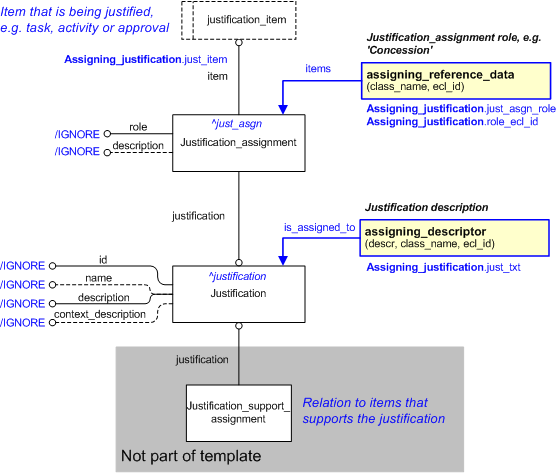

target
is the parameter to which the
Justification_assignment
is bound.
target
is the parameter to which the
Justification
is bound.
| Entity in path | Value | Inherited from |
| Justification.id | '/IGNORE' | — |
| Justification.name | '/IGNORE' | — |
| Justification.description | '/IGNORE' | — |
| Justification.context_description | '/IGNORE' | — |
| Justification_assignment.description | '/IGNORE' | — |
| Justification_assignment.role | '/IGNORE' | — |
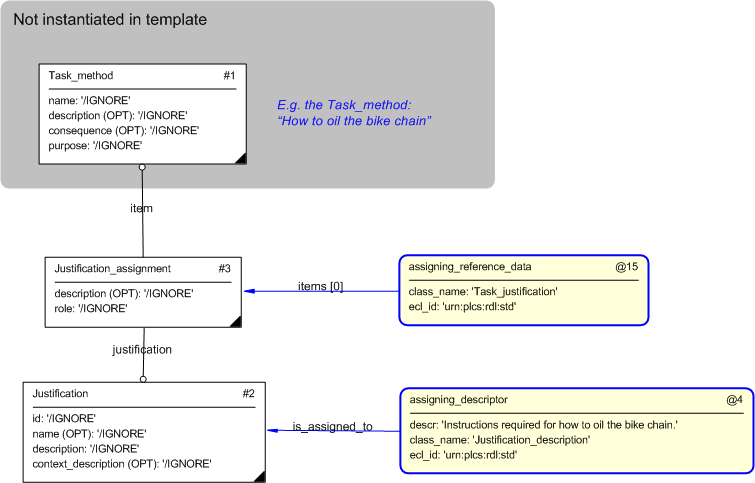
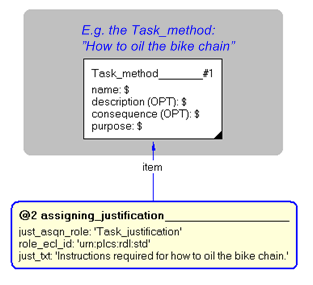
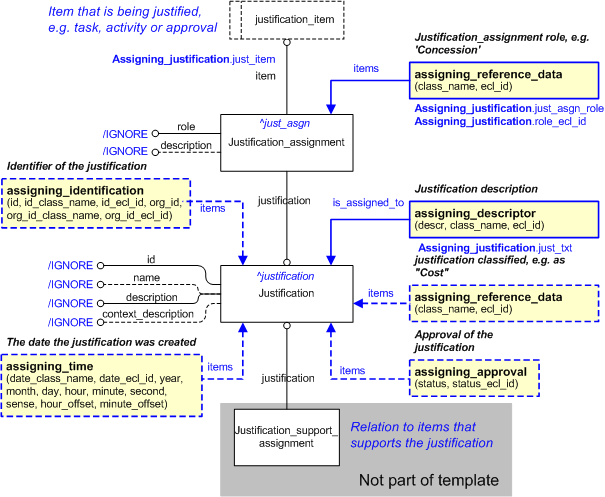
NOTE this characterization is optional.
Dates can be associated with the assignment of property value representation by using the templates assigning_time.
A creation date is commonly assigned to the template assigning_justification
The date of creation of the justification is represented by using the template assigning_time to assign a date and time to Justification (reference parameter ^justification ) The date and time assignment is classified as: "Date actual creation" (urn:plcs:rdl:std:Date actual creation) to indicate that it is the date (and time) when the justification was actually created.
Other dates may be assigned instead.
NOTE this characterization is optional.
The Justification is identified by assigning it an identifier through the use of template assigning_identification.
NOTE this characterization is optional.
The Justification can be "approved" by assigning an approval through the use of template assigning_approval
NOTE this characterization is optional.
The Justification can be classified, e.g. cost, is represented using the template assigning_reference_data.
This section specifies the template assigning_justification_support_item.
NOTE An explanation of a template and the associated instantiation path is provided in the Template overview section.
This template describes how to represent supportive information to a justification, e.g. a state definition, a supportive document, a property value, i.e. anything that supports the justification and reason for divergence or discrepancy.
This template is intended to be used when supportive information exists, or when a simple textual description of the justification is not enough. It is used together with template assigning_justification. Any number of support items may be assigned to a single justification.
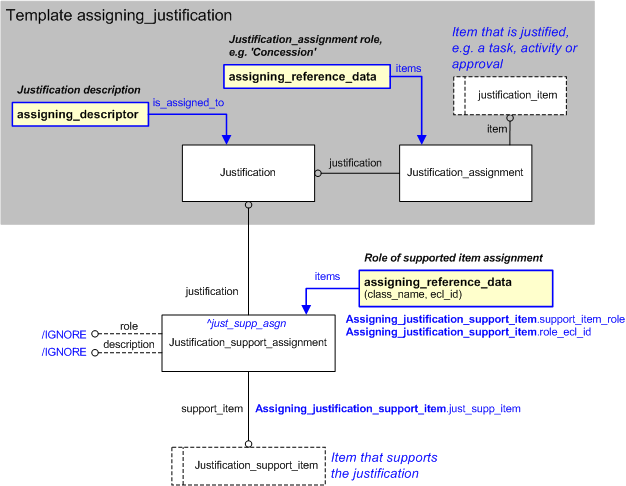

target
is the parameter to which the
Justification_support_assignment
is bound.
| Entity in path | Value | Inherited from |
| Justification_support_assignment.description | '/IGNORE' | — |
| Justification_support_assignment.role | '/IGNORE' | — |

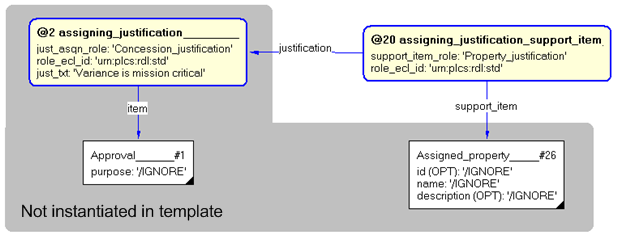
This capability "Representing justification" is dependent on the following capabilities:
The following classes of reference data are required for this capability:
© OASIS 2010 — All rights reserved